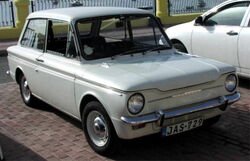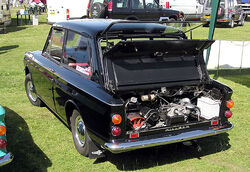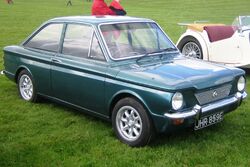[[File: |frameless|upright=1.25|alt=]] |frameless|upright=1.25|alt=]] | |
| Manufacturer | Rootes Group |
|---|---|
| Production |
1963-1976 440,032 made[1] |
| Predecessor | none |
| Successor | Chrysler Sunbeam |
| Body style(s) |
2-door coupe (Californian) 2-door saloon 3-door estate (Husky) 3-door panel van (Commer Imp) |
| Engine(s) | 874 cc Straight-4 Overhead camshaft |
| Transmission(s) | 4-speed manual all-synchromesh.[2] |
| Wheelbase | 2,082 mm (82.0 in) |
| Length | 3,581 mm (141.0 in) [2] |
| Width | 1,524 mm (60.0 in) [2] |
| Height |
1,385 mm (54.5 in) Saloon 1,330 mm (52.4 in)[3] Coupe 1,475 mm (58.1 in)[2] Hillman Husky/Commer Imp |
| Kerb weight | 725 kg (1,598 lb) |
| Fuel capacity | 27.5 L (7.3 US gal/6.0 imp gal)[4] |
| Related |
Hillman Californian Singer Chamois Sunbeam Sport |

Hillman Imp, with the engine cover and the rear window lifted

The Singer Chamois version sold at a premium: additional features included a distinctive false grill and, from October 1969, twin headlights.

'Coupe' variants badged respectively as the Hillman Imp Californian, the Sunbeam Stiletto and (as here) the Singer Chamois coupe featured a more steeply raked rear window which could not be opened.
The Hillman Imp is a compact, rear-engined saloon car that was manufactured under the Hillman marque by the Rootes Group (later Chrysler Europe) from 1963 to 1976. A small van, the Commer Imp, was introduced in November 1965[5] and an estate version, using most of the same panels but with side windows behind the b-pillar, known as the Hillman Husky was produced from 1967.
History[]
Known internally within Rootes as the "Apex" project the Imp was to be the first post-Second World War small car by the Rootes group. Its main rival on the home market at least was to be the BMC Mini which preceded the Imp by nearly four years. The Imp was intended as a small car with all the usual Rootes hallmarks. One key difference between the two cars was the Imp's 875 cc all-aluminium power unit, adapted by Rootes from a Coventry Climax fire pump engine which had enjoyed some success on the racing scene. The Imp used a derivative of the Climax FWMA engine whereas Lotus mainly used the FWE engine for their Elite model. In fact Lotus were instrumental in ordering several engine types from Coventry Climax some of which were subsequently taken in production and were marketed by Coventry Climax.
The engine used for the Imp was considerably different from the original Climax engine, for instance having an entirely different cylinder head. The Imp's engine was mounted behind the rear wheels, slanted over at 45° to fit, this was done to keep the center of gravity low and to minimise its effects on the roadholding of the car. Rear-engined cars generally suffer from oversteer handling characteristics to some extent, and to counteract this as much as possible the Imp had a semi-trailing arm independent rear suspension system. This relatively costly and sophisticated solution which was atypical for small car design at the time was insisted upon by its designers after testing at length a Chevrolet Corvair[6] with swing axles. Unusually, to attain balanced handling, the Imp actually used swing axle geometry at the front, however this initially led to too much understeer and the camber was later reduced by lowering the pivot points.[7] Rootes relied upon a team led by two young designers, Tim Fry and Mike Parkes who were given an almost free hand to come up with a small car that would fit well into the Rootes car programme. This at the time centered on derivatives of the Hillman Minx car.
Over the life of the car, Rootes (and later Chrysler UK) produced three basic body styles. The original Saloon was introduced in May 1963 with an opening rear window and ran through to the end of production in 1976. A coupe was introduced in 1965, that same year the van was introduced as Commer Imp and its pressings were later used to create an estate badged as a Hillman Husky in 1967. Several prototypes of estate car using the saloon type car with extended rooflines were tried but perhaps unwisely never offered to the public. Instead buyers choosing the estate had to live with a van derived car with somewhat uneasy styling. Both van and estate were to be retired in 1970. Through the use of the opening rear window on saloon models, the car was effectively a hatchback. The opening rear window was intended to ease loading the small luggage area behind the fold down rear seat squab. That feature itself was one of the first in small car design it being a feature more at home in larger more upmarket estate cars at the time. In an attempt to interest a wider public when sales figures fell well short of the intended 100,000 or more cars per annum, some badge-engineered derivatives, such as the luxury Singer Chamois (launched October 1964), and the Sunbeam Sport (launched October 1966) with a more powerful twin-carburettor engine were on offer with various degrees of success. For marketing reasons in many export markets the Singer badged cars were sold as Sunbeams, even before May 1970 when the Singer marque was discontinued altogether by Chrysler UK.[8]
The coupe bodyshell was broadly similar to the standard body but featured a more steeply raked windscreen and a similar rear window which, unlike that on the standard bodied cars, could not be opened. Much to the disappointment of the designers the somewhat faster looks did not translate into better acceleration and top speed figures. In fact aerodynamics of the standard saloon are slightly better. The new body style made its first appearance at the Paris Motor Show in October 1967 with the introduction of the sporting Sunbeam Stiletto.[2] The coupe body had also turned up, with less powerful engines, in the Hillman Imp Californian announced in January 1967[3] and the more luxurious Singer Chamois coupe.
The Imp was a massive and expensive leap of faith for Rootes. The company did not have any recent experience building small cars even though it started off as a car builder by offering the then small Hillman Minx back in 1931. That car had since grown larger and larger, by the time the Imp was introduced it was well established as a medium-size family car. Rootes took upon them to pioneering the use of aluminium engines in an important mass production car. They would soon find out that doing so was rather more complicated than simply substituting a well known and trusted cast iron design for a new aluminium design. Rootes had to build a new computerised assembly plant on the outskirts of Glasgow, in the town of Linwood in which to assemble the Imp, since planning regulations banned it from further expanding its Ryton plant near Coventry.[citation needed] Government grant money, was offered to bring jobs (approx 6000) to this unemployment blackspot, which had suffered many redundancies in the declining shipbuilding industry on the banks of the river Clyde. The investment also included an advanced die-casting plant to manufacture the aluminium engine casings, and a stake in a brand new Pressed Steel Company motor pressings works which manufactured all the new car's body panels. One of the many problems was that Linwood was over 300 miles (480 km) away from Ryton, and the engine castings although made in Linwood, would have to be sent to Ryton to be machined and assembled, and then sent back up to be put on the cars – a 600-mile (970 km) round trip. In the end a complex schedule of trains shifting completed cars and raw castings down south and trains loaded with engine – gearbox assemblies and many other Ryton sourced goods ran north for the duration of Linwood Imp production.
The Glaswegian workforce, who were mainly recruited from the shipbuilding industry were not versed in the intricacies of motor vehicle assembly, and Imp build quality and reliability suffered accordingly. Many years later Alfa Romeo suffered similar problems when they established Alfasud in Naples as a production satellite of Alfa Nord in Turin. Industrial disputes and strike action were commonplace. In 1964 there were 31 stoppages and only a third of the plant capacity was realised – 50,000 rather than 150,000.[citation needed] On the other hand the Imp was seen as a "Scottish car" and was popular north of the border.[citation needed]. Later the Imp was allowed to evolve from a revolutionary new car intended for Rootes customers who intended to buy their wives a second car, a quality small car with some above average features at that, into a kind of ultra cheap car with cheaply, even some poorly executed, design features on offer as a kind of British Skoda. At one point the basic Hillman Imp was the cheapest new car on the British market, which temporarily pushed up rather sluggish sales figures.
The daring design of the Imp was underdeveloped, due in part to the government timetable to start production. Mechanical and cooling system problems were commonplace in the early cars. In 1966 a major revision of the Imp was released, effectively splitting the marque into Mk I and Mk II cars. The Mk I Imps had a pneumatic throttle linkage and automatic choke, both of which were replaced by more conventional items on the Mk II. The Mk II also had improved front suspension geometry and a host of trim and detail changes. Although the car was constantly improved over its life there was no single change as big as that in 1966.
A further upgrade took place in 1968, however: the driver was now confronted with a revised instrument panel and steering wheel.[9] The large speedometer previously at the centre of the view through the steering wheel was replaced by a horizontal row of four circular dials/displays of varying detail and complexity according to the model specified.[9] The right hand dial, the speedometer, was now to one side of the driver's normal sightline, while one multi-functional stalk sticking out from the right side of the steering column replaced the two less ambitiously tasked control stalks that in the earlier cars had sat directly behind the steering wheel, one on each side.[9] The earlier Imp had won plaudits for the ergonomic excellence of its dash-board / fascia, and the replacement of it reflected similar trends apparent in several new and modified UK models at the time, undertaken in the name of "production rationalization": on the Imp the more modern arrangement was seen by some as a missed opportunity.[9]
The initial problems damaged its reputation and popularity tailed off, with half of all production being from the first three years. It still sold thanks to its competitive price, distinctive styling and cheap running costs, but sales never lived up to expectations for what had become a very competent small car. Another problem that contributed to the reputation of poor reliability, was the lack of understanding of the maintenance needs of alloy engines by owners and the motor trade in the 1960s. It was overshadowed in popularity by the Mini. Although the Mini initially sold poorly, by the mid '60s it was the in thing to have, and the Imp never enjoyed its status as a fashion statement.
The huge investment in both the Imp and the Linwood production plant proved to be one of the reasons for the undoing of Rootes Group, and its commercial failure fuelled the huge losses suffered although the main reason for Rootes Group losses were industrial unrest and the effects of the forthcoming cooperation with Chrysler Corporation of the USA. Initiated by Lord William Rootes in 1964 as a partnership the signs were soon on the wall. Lord Rootes died in October and soon after the deal began to take a turn for the worse from a Rootes point of view. By 1967 the company had been acquired by Chrysler, to become part of Chrysler Europe,long after, to be overshadowed by the French Simca. A year later, ahead of the 1968 London Motor Show, the recommended retail prices of most Imp models were reduced for the domestic market by more than 4%,[10] despite the general price inflation affecting the UK. Chrysler stewardship was blamed by some for the demise of the Imp in March 1976,[citation needed] after fewer than 500,000 had been built and the entire empire collapsed two years later, when it became part of Peugeot.
The Linwood plant was closed in 1981. The Ryton assembly plant continued in operation until 2006, manufacturing Peugeot models.
Production[]
Approximately half a million, 50% of those in the first 3 years of production. The Imp used a derivative of the Climax FWMA engine whereas the Lotus cars used a FWMC engine which had an entirely different cylinder head.
Export[]
Unassembled cars were exported for assembly in Ireland, New Zealand, Portugal, Venezuela, Uruguay, Costa Rica, South Africa and Australia.
Imp variants[]
- Hillman Imp
- Hillman Imp Mark I
- Hillman Imp de Luxe Mark I & Mark II
- Hillman Imp Super
- Hillman Imp GT (Australian model)
- Hillman Californian (coupé / fastback saloon version)
- Hillman Husky (estate version of the Imp from 1967)
- Commer Imp Van (from November 1965)
- Hillman Imp Van
- Singer Chamois Mark I, Mark II, Sport, & Coupé (upmarket, luxury versions of the Imp)
- Sunbeam Imp Sport
- Sunbeam Sport
- Sunbeam Chamois & Chamois Coupé (luxury version of the Imp)
- Sunbeam Stiletto
- Sunbeam Californian
- Sunbeam Imp Basic (North America)
- Sunbeam Imp De Luxe Mark I & Mark II (North America)
Cars using Imp mechanicals[]
- Clan Crusader
- Ginetta Cars G15
- Davrian Imp
- Bond 875 & variants
- Siva Llama
- Beach Mk4
Imps in motorsport[]
The Imp enjoyed modest success in both club and international rallying. Rootes introduced a homologation special called the Rally Imp in 1964. The Rally Imp featured many modifications over the standard model, the most important of which was an engine enlarged to 998 cc. Notable successes for this model include the 1965 Tulip Rally in which the works Imps of Rosemary Smith and "Tiny" Lewis finished first and second overall.
Imps were also successful racing cars. The privateer team of George Bevan dominated the British Saloon Car Championship (later known as the British Touring Car Championship) in the early 1970s. Driven by Bill McGovern, the Bevan Sunbeam Imp won the championship in 1970, 1971 and 1972 with limited factory support. In UK club racing the Imp variants became highly successful in the under 1000 cc Special Saloon category, Notable exponents of the Imp in racing include Ian Forrest, Harry Simpson, Ricky Gauld, John Homewood, Roger Nathan, Gerry Birrell, Ray Payne, Chris Barter and many others.
The imp was also successfully raced and rallied in other parts of the world, notably Asia where Drivers like Andrew Bryson and Pardaman Singh regularly won saloon car categories even till as late as the eighties.
998 cc Imp engines were also used in 3-wheeled racing sidecars in the 1970s and 1980s. Exhaust systems were naturally constructed on a one off basis, and often sporting the Twin Weber twin choke set up. A number of sidecar crews raced Imp-engined outfits at the Isle of Man TT races,[11][12] best placement being Roy Hanks in eleventh place in the 1976 TT 1000cc Sidecar.[13] Imp-engined outfits are still regularly championed in classic racing.[14]
The engine proved flexible and very easy to tune. The overhead camshaft design meant that the head could be flowed and ported to allow the engine to run at high speeds. Useful improvements in power could be gained by replacing the standard silencer with one that impeded the exhaust gas flow less and with better carburettors. However, in adapting the design to suit modern mass production methods, Rootes had left the engine somewhat more fragile than its Coventry Climax parent.
Preservation[]
A number of these cars exist in preservation and they have a following atracted by there quirky design.
- please list any known examples below;
Hillman Imp/PML
Bibliography[]
- Mowat-Brown, George: Hillman Imp: The Complete Story; The Crowood Press Ltd (24 Nov 2003); # ISBN 1-86126-619-7 : # ISBN 978-1-86126-619-4
References[]
- ↑ Robson, G. (2006). A-Z of British Cars 1945-1980. Devon, UK: Herridge Books. ISBN 1-9541063-9-3.
- ↑ 2.0 2.1 2.2 2.3 2.4 "Road Test Hillman Husky", Autocar 127 (nbr3738): pages 17–22. 5 October 1967. Cite error: Invalid
<ref>tag; name "Autocar1967" defined multiple times with different content - ↑ 3.0 3.1 "New Sunbeam Stiletto", Autocar 127 (nbr3738): pages 30–31. 5 October 1967.
- ↑ Daily Express Motor Show Review 1975 Cars: Page 22 (Hillman Imp). October 1974.
- ↑ "News and Views", Autocar: page 997. date 5 November 1965.
- ↑ [1] http://www.imps4ever.info/tech/suspense.html
- ↑ [2] http://www.imps4ever.info/tech/suspension.html
- ↑ [3]
- ↑ 9.0 9.1 9.2 9.3 "Out of step", Motor: page 56. 22 February 1969.
- ↑ "News and views: Hillman Imp Price: important cuts", Autocar 129 (nbr 3791): page 104. date 10 October 1968.
- ↑ IoM TT Race results, Imp outfits
- ↑ IoM TT Race results, Chrysler outfits
- ↑ IoM TT Race result, 1976 TT 1000cc Sidecar
- ↑ CMRC
External links[]
- The story of the Imp
- The Imp Club
- The Hillman Imp and its badge engineered cousins
- Andys hillman Imp home page : This site is all about Hillman Imps and their imp engine derivatives.
Template:Hillman vehicle range
| This page uses some content from Wikipedia. The original article was at Hillman Imp. The list of authors can be seen in the page history. As with Tractor & Construction Plant Wiki, the text of Wikipedia is available under the Creative Commons by Attribution License and/or GNU Free Documentation License. Please check page history for when the original article was copied to Wikia |